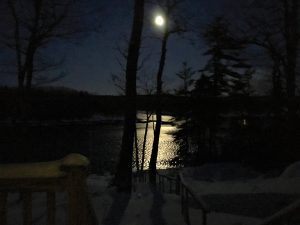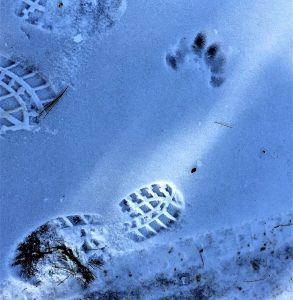Tracks in the Cold
If you want to know your animal neighbors, let it snow. A fresh coating of pure powder is a perfect, unspoiled canvas on which critters paint time-lapse landscapes of their comings and goings. 
I grew up in a four-room wooden farmhouse in Indiana with no central heat. We had a brown porcelain oil-fired space heater in the living room and, as far as I remember, no means of conducting the heat to other places in the house, save convection. Still, I didn’t dread the cold, not really.
Here are two things that come to mind about that old house, the cold, and growing up. First, I was afraid that a fox would gnaw his way through the wooden siding and get into the bedroom my brother and I shared. Foxes, for some reason, had taken on mythical powers in my young mind. They gave me bad dreams.
The truth is I can hardly remember seeing a fox, as a boy. But on a small isolated Indiana farm, they were a bona fide threat to chickens. So, I must have inferred an existential threat. Officially, foxes were a pest in our neck of the woods because Hendricks County agricultural authorities paid three dollars bounty for a set of their severed ears. I cashed in only once. I used a Buck pocket knife to cut my submission from a road kill.
My other cold remembrance–fox related–happened on the cusp of spring, in late March or early April. That’s when day-old baby chicks arrived from the Indiana Farm Bureau Co-op. We usually ordered a hundred, or so. They were delivered by mail via a United States Postal Service rural route carrier. The cheeping, fluffy little hatchlings would grow to be egg-layers and fryers by summer.
The chicks lived in a flimsy wooden hen house in our smokehouse lot. There, they were kept warm courtesy of the Rural Electric Membership Cooperative, because they were vulnerable and missed their natural mothers. Their heat came from two lamps that hung over their straw-floored pen and glowed red like alien suns. The chicks would huddle and bunch under these lights and often smother one of their own. Poor things, flocking was in their genes.
During a cold snap, when the heat lamps weren’t enough, mom would bring the chicks into the house. She’d lay newspapers down in front of the oil burner in our living room and build a barrier out of who knows what to pen them in. Thus, my brother and I would have a single-species petting zoo until the weather warmed.
I didn’t think, at the time, that having chicks in the living room was wildly unusual. I assumed that other farm families were doing the same thing. We weren’t a poor family, not like our nearest neighbors. They were sharecroppers. They may not have had indoor plumbing. I don’t know; I was never allowed to go into their house although I often visited to play with their oldest boy. My father had a union job at Detroit Diesel Alison, a division of General Motors. He was a proud experimental machinist. Dad liked his work, and that was good because he spent almost every day there and he worked a lot of overtime, too.
In fact, dad and mom saved enough money that we built a new house. And, I mean, we built it. It was made of Bedford Limestone and still stands today, fifty years on. As young boys, our contribution was marginal. But my mom and dad worked really hard over three years to dig a basement (with the help of a backhoe), lay the block and foundation (with the help of the first African-American I ever met), frame the house (with the help of dad’s work buddies), set the stone (with the help of a journeyman mason) and wire the electrical circuits, plumb the fixtures and install the 1960 state-of-the-art, hot-water-in-the-floor-and-ceiling heating system.
So, with the new house finished and no sentimentality to hinder further progress, my father and mother hired a bulldozer. The operator plowed a big hole in our front yard and shoved the old house in. It went down like cardboard. Then, he covered the hole with high-grade Indiana topsoil. Buried in that dark hole was the cold of my youth and my fear of foxes chewing their way into my bedroom. Foxes can’t gnaw through Bedford Limestone; everybody knows that.
Now, we have foxes in Maine, I’ve seen them. And, coyotes, unseen but not unsung. I know the tracks from both. And in Maine, we have other substantial mammals who prefer meat for dinner. So, when I came across a fresh track on our access road that was almost half the length of my size-12 Bean boot, I was curious. I like to know my neighbors, especially the larger ones.
The track didn’t match any image provided by Google. So, armed with a loaded iPhone, I queried locals at Grover’s Hardware, and Dan’s Auto, and a Sawyer Island dinner party. I asked mostly Mainers, and I received non-definitive suggestions ranging from bear to bobcat. One opinion from a life-long son of the Pine Tree State even suggested catamount, very controversial.
So, for the sake of neighborliness, and by harnessing the boundless wisdom of the internet, I open the discussion to all reading this blog. You can reach me via my contact page for your solicited wildlife analysis. Here’s thanking you in advance. – SJH






